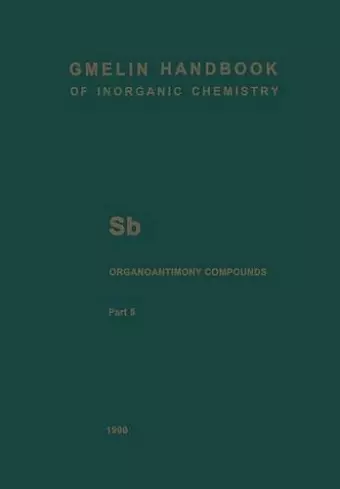Sb Organoantimony Compounds
Part 5: Compounds of Pentavalent Antimony with Three, Two and One Sb-C Bonds
Marlies Mirbach author Markus Wieber author Ulrich Krüerke editor Marlis Mirbach editor
Format:Paperback
Publisher:Springer-Verlag Berlin and Heidelberg GmbH & Co. KG
Published:3rd Oct '13
Currently unavailable, our supplier has not provided us a restock date

Springer Book Archives
This fifth volume on organoantimony compounds continues the description of pentavalent antimony compounds and concludes the entire series. The treatment of pentavalent compounds with three Sb-C bonds began in Part 4 with the RSbX type and is now completed with types RSb(X)Y, RR'SbX , RR'Sb(X)Y, 3 2 3 2 2 2 RR'R"SbX (Section 2.5.1) and the corresponding bi- and trinuclear compounds (Sec- 2 tions 2.5.2, p.87, and 2.5.3, p. 132). R, R', and R" denote different organic groups bonded through carbon to the antimony atom. X and Y represent inorganic or organic groups that are bonded to antimony by an atom other than carbon. R, X, and/or Y can also be chelating ligands. The remaining part of the volume completeLy covers all pentavalent antimony compounds containing two Sb-C bonds (RSbX , RSb(X )Y, RR'SbX , RR'Sb(X )Y, bi- and tetranucLear 2 3 2 2 3 2 compounds, Chapter 2.6, p. 134) and those containing one Sb-C bond (RSbX , RSb(X )Y, 4 3 RSb(X)Y , bi- and trinucLear compounds, Chapter 2.7, p. 237). These compounds form ad- 2 2 ducts with Lewis bases (symbol D) and form many ionic compLexes by the addition of saLts such as amine hydrochLorides (symbol MZ). The adducts and ionic compLexes are described immediately after the parent substances. The volume concludes with an Empirical Formula Index (p. 318) and a Ligand Formula Index (p. 357).
ISBN: 9783662063149
Dimensions: unknown
Weight: unknown
407 pages
8th ed. 1990. Softcover reprint of the original 8th ed. 1990